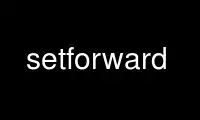
This is the command setforward that can be run in the OnWorks free hosting provider using one of our multiple free online workstations such as Ubuntu Online, Fedora Online, Windows online emulator or MAC OS online emulator
PROGRAM:
NAME
setforward - create a forwarding database
SYNOPSIS
setforward cdb tmp
DESCRIPTION
setforward reads a table of forwarding instructions from its standard input. It converts
the table into a forwarding database. The forwarding database can be used by fastforward.
setforward writes the forwarding database to tmp; it then moves tmp to cdb. tmp and cdb
must be on the same filesystem.
If there is a problem creating tmp, setforward complains and leaves cdb alone.
The forwarding database format is portable across machines.
INSTRUCTION FORMAT
A forwarding instruction contains a target, a colon, a series of commands, and a
semicolon. Each command is a recipient address, owner address, external mailing list, or
program. Commands are separated by commas.
For example,
[email protected]: [email protected], [email protected];
says that mail for [email protected] should be forwarded to the recipient addresses
[email protected] and [email protected].
When setforward sees # it ignores all text from # to the end of the line:
# this is a comment
setforward ignores all other line endings, so you can split a forwarding instruction
across lines. It also ignores spaces and tabs. Exception: you can put a space (or tab or
comma or whatever) into a target or command by putting a backslash in front of it.
(However, NUL bytes are not permitted anywhere.)
TARGETS
When fastforward sees the incoming address [email protected], it tries three targets:
[email protected], @host.dom, and user@. It obeys the commands for the first target that it
finds. Target names are interpreted without regard to case.
All the commands for a single target must be listed in a single instruction. Exception:
an owner address can be listed in a separate instruction.
RECIPIENT ADDRESSES
If a command begins with an ampersand, setforward takes the remaining bytes in the command
as a recipient address:
[email protected]: &[email protected];
fastforward sends each incoming mail message to the recipient address. The recipient
address must include a fully qualified domain name. It cannot be longer than 800 bytes.
If a recipient address is itself a target in the forwarding table, fastforward will
recursively handle the instructions for that target. Note that @host.dom and user@
wildcards do not apply here; they apply only to the incoming address.
If a command begins with a letter or number, setforward takes the entire command as a
recipient address:
[email protected]: [email protected];
OWNER ADDRESSES
If a command begins with a question mark, setforward takes the remaining bytes in the
command as an owner address:
[email protected]: ?[email protected];
fastforward uses that address as the envelope sender for forwarded mail, so bounces will
go back to that address. (Normally, if a message is forwarded to a bad address, it will
bounce back to the original envelope sender.)
EXTERNAL MAILING LISTS
If a command begins with a dot or slash, setforward takes the entire command as the name
of a binary mailing list file created by setmaillist:
[email protected]: /etc/lists/sos.bin;
fastforward will read and obey the commands in that file. The file must be world-readable
and accessible to fastforward.
PROGRAMS
If a command begins with a vertical bar or exclamation point, setforward takes the rest of
the command as the name of a program to run:
dew@: |dew-monitor;
For a vertical bar, fastforward feeds the message to that program. An exclamation point
works the same way except that fastforward inserts $UFLINE, $RPLINE, and $DTLINE in front
of the message.
DUPLICATES
When fastforward is building the recipient list for a message, it keeps track of the
recipient addresses and external mailing lists it has used. If the same command shows up
again, it skips it. For example:
[email protected]: [email protected], [email protected];
[email protected]: [email protected], [email protected];
[email protected]: [email protected], [email protected];
A message to [email protected] will be sent to [email protected] only once. (This also means that
addresses in an internal forwarding loop are discarded.)
Exception: If a target has an owner address, commands for that target are considered
different from commands for ``outside'' targets.
Use setforward online using onworks.net services
